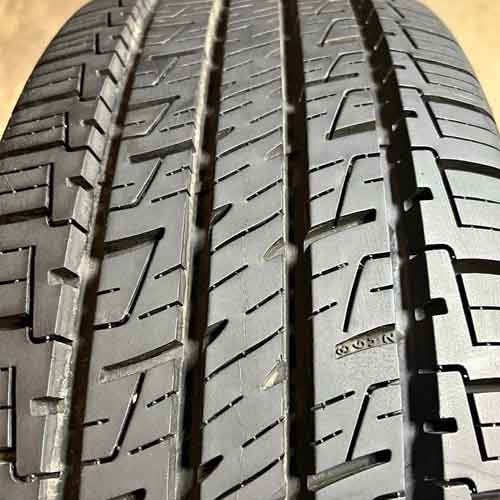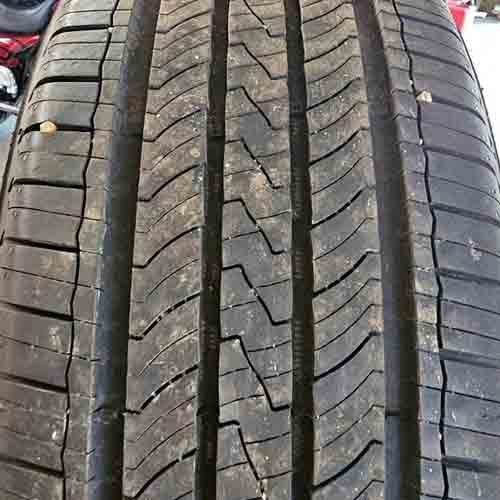Cooper’s Endeavor Plus, known for its quiet ride and all-season grip, goes head-to-head with Goodyear’s Assurance MaxLife, celebrated for its long-lasting tread and dependable performance.

Each tire has its pros and cons, so it highly depends on your specific needs. If you prioritize superior dry handling, fuel economy, and long tread life, then the Goodyear Assurance MaxLife may be the better fit for you. On the other hand, if you value wet and winter traction as well as ride quality, the Cooper Endeavor Plus might better align with your requirements.
Table of Contents
Tire Sizes
The Goodyear Assurance MaxLife comes in 15 to 20 inches wheels, and all of those sizes have following specs.
- Speed ratings: H and V.
- Load ratings: SL and XL.
- Tread depth range: 11 to 12/32″.
- Weight range: 20 to 36 lbs.
- Treadwear warranty: 85k miles.
- UTQG rating: 820 A B.
Review this tire in greater details: https://tiredriver.com/goodyear-assurance-maxlife-review/
The Cooper Endeavor Plus comes in 16 to 22 inches wheels, and they come with the following specifications.
- Speed ratings: T, H and V.
- Load ratings: SL and XL.
- Tread depth range: 10.5 to 12.5/32″.
- Weight range: 22 to 42 lbs.
- Treadwear warranty: 65k miles.
- UTQG rating: 680 AA.
Review this tire in greater details: https://tiredriver.com/cooper-endeavor-plus-review/
Tread Design
Let’s start from the Assurance MaxLife, which offers an symmetric tread.

All these ribs further enhance stability as they’re basically placed on a (longitudinal) secondary rubber layer which provide all lugs with reinforced foundational supports.
So the lateral grooves these lugs have in between act as in-groove notches, especially in case of shoulders.
These shoulder lugs also have F shaped siping pattern and notches facing the middle.
Speaking of which, the middle 3 ribs although make 4 circumferential channels, they don’t interconnect with each other properly.
Though these ribs have a wide array of notches and siping, just like its shoulders.
Internally, the tire comes with a single ply polyester casing and just a single ply nylon cap.
Though it also carries 2 steel belts in the middle, so the durability is not compromised with that, as well.
On the other hand, the Endeavor Plus also comes with a similar 5 rib symmetrical pattern. Though its slightly more aggressive.

Its 3 middle ribs are although sitting on a continuous running rubber layers underneath, they are more voided up in comparison to MaxLife.
As one can clearly see, all ribs have lateral voids on them, eating away the rubber.
Though due to their interlocking design, they provide biting edges.
Moreover, with them connecting up the 4 circumferential channels, they make, they also offer better resistance to hydroplaning.
Though this doesn’t go for shoulders, where the lateral voids are blocks up.
This is primarily for reducing noise. Cooper calls it the whisper grooves technology.
Internally tire comes with 2 ply polyester, with 2 steel belts, and a single, nylon reinforcement ply is also added on the very top, which aids handling.
Highway Performance
Both tires demonstrate exemplary performance in various aspects, from dry traction to steering response and high-speed stability. Let me explain them all.
Linear Grip
The term ‘linear grip’ is self-explanatory, as it measures a tire’s friction with the road during straightforward motion, like when driving on highways.
As its a directional metric, it’s primarily an assessment of the tire’s braking capability.
Now comparing both tires here, one can explain why the Goodyear Assurance MaxLife offers better braking efficacy, as seen by its shorter stopping distances (on tests).
This is attributed to its central ribs, which are backed by reinforced foundations. This design provides notable stability, enhancing the direct feel during driving. (See its tread pattern, which shows how lugs are sitting on a secondary rubber layer).
Moreover, its lighter construction means reduced momentum inertia, allowing it to decelerate more efficiently during braking, further adding to its longitudinal traction.
Dry Handling and Steering
When discussing cornering, three essential phases come into play:
- Entry Phase: This initial phase sees the vehicle preparing to make the turn, often involving braking and potential downshifting.
- Mid-Cornering: This is the pivotal point of the turn, where precise steering feedback is paramount.
- Exit Phase: The final stage involves the vehicle realigning and reintroducing acceleration.
Now the Goodyear Assurance MaxLife excels across all these stages, offering unmatched steering precision.
As already explained above, the tire offers superior braking, so it enters the corner faster. Moreover, it also provides a tangible sense of the tire’s grip, while in the middle of the corner.
And its weighty steering (in comparison), also gives out a better on-center feel, so it’s excels in exiting phase too.
On the flip side, the Cooper Endeavor Plus lacks the sporty sensation MaxLife delivers.
I mean although it offers similar cornering grip (as seen by lateral g forces), it’s heavier weight gets in the way, and hurts its overall handling times on laps (It’s a whole second slower).
Basically greater weight puts more pressure on the lugs, and cause them to bend more. This deformation of the tread, then translates in to lacking under and oversteering balance.
Fuel Economy
Fuel consumption is shaped by a multitude of factors, where tread composition and the overall construction weight are the main ones.
In this context, the Goodyear Assurance MaxLife takes the lead, showcasing smaller rolling resistance in comparison.
Out of both tires, its structure is overall lighter, and on top of that it also features a stiffer rubber composition (relatively).
Both these prevent significant deformation of the tread (as the tire maneuvers).
This deformation basically adds to the energy expenditure, lowering overall fuel economy, and it’s exactly why Cooper lacks here.
Wet Traction
In wet conditions, the Cooper clearly stands out, delivering superior resistance to hydroplaning and enhanced wet grip.
These two factors, basically are linked with tire’s ability to dispel water. I mean, the majority of water gets out with the help of grooves, while the residual water is managed by the sipes.
These sipes suck in the water particles (in their slits), as they flex and create a suction.
Now as the Endeavor Plus offers a better inter-connectivity of its longitudinal channels, more water is able to disperse off the tread, thereby reducing the burden on the sipes.
And with its relatively softer tread compound, its sipes also work better, facilitating water absorption with more ease.
On the flip side, Goodyear Assurance Maxlife although features a lot of biters and has ample siping, its harder rubber composition reduces the sipes’ ability to manage water as effectively, in comparison.
And that, combined with the it’s continuous running ribs, the tire struggles to evacuate water efficiently, especially laterally, which in turn compromises its overall wet traction.
Ride Quality
Ensuring optimal ride quality depends on two areas, noise reduction, and how well the tire deals with road imperfections. Let’s talk about them in detail.
Noise
Tire noise arises from various factors, including rolling resistance, groove resonance, and tread design, where the most significant contributor is the movement of air particles.
As the tire rolls, these particles collide with the tread walls, producing the primary source of sound.
This is why tires with packed shoulders are recommended, as they serve as a primary barrier to air entry. So that makes sense why both tires are pretty quiet options.
Though, overall, the Cooper Endeavor Plus is slightly more lacking, if you still have to pick one here, where it produces a prominent cyclical noise, especially when transitioning to smoother terrains.
Vibrations Comfort
Tire comfort is significantly determined by the tire’s ability to mitigate road imperfections. This quality is largely influenced by both the rubber’s composition and the tread design.
In this context, the Goodyear Assurance MaxLife, although showcasing a cutting-edge tread compound, finds its stiffer rubber composition slightly compromising its capacity to dampen road vibrations effectively.
Whereas the Cooper Endeavor Plus ensures a relatively consistent ride smoothness, with its softer compound, where its (slightly) greater tread depth also helps, since it gives more room to vibrations to settle down.
Tread Wear
Tread longevity is crucial, with two primary considerations:
- The rate at which the rubber degrades.
- And the duration until the tread diminishes to 2/32″ (which is the minimum tread depth, tires are allowed to run with in U.S. legally).
Considering both of these, it makes clear sense why the Goodyear Assurance MaxLife not just excels here compared to Cooper, but offers one of the best tread life in its all season category.
This tire’s advantages from its comparatively lighter weight and continuous lug/rib design, with foundational supports, (as all ribs are sitting on secondary rubber layers).
These features decrease the pressure and heat upon contact with the road, reducing wear. While, its harder rubber composition further improves that, (as the polymers in its composition fights off wear).
The result? You get impressive 85k-mile warranty.
Winter Traction
Evaluating a tire’s efficiency in winter conditions involves weighing various factors, such as grip, handling, and versatility on diverse terrains.
Now here although both tires don’t come with the 3 Peak Mountain Snowflake certification, the Cooper Endeavor Plus still gets to offer better overall traction, especially when it comes to (soft) snow.
This superior performance is basically attributed to its design features, where you see abundant siping, multi-angled patterns, and zigzag notches.
These elements ensure excellent snow-to-snow contact, (vital because snow adheres more effectively to snow than to rubber). And so you get a more dependable braking and acceleration in comparison.
On the other hand, the Goodyear Assurance MaxLife falls short, especially in lateral traction and steering responsiveness.
And that’s mainly because of its harder compound, which tends to become more rigid in freezing temperatures.
Additionally, the absence of interlocking biters, evident on the Cooper, means the Goodyear tire cannot achieve the same level of snow-to-snow contact, and therefore overall winter performance.
So The Verdict?
So overall, both tires prove to have their unique strengths and areas of improvement across different driving scenarios. Let me break it down.
Goodyear Assurance MaxLife stands out in:
- Linear grip and braking, attributed to its central ribs and lighter construction.
- Dry handling, where it excels in entry, mid-cornering, and exit phases.
- Fuel economy, as its lightweight structure and stiffer rubber composition reduce rolling resistance.
- Tread wear, with its innovative design and harder rubber offering one of the best tread lives in its category and an 85k-mile warranty to back it up.
On the other hand, the Cooper Endeavor Plus shines in:
- Wet traction, owing to its superior groove design and softer tread compound, which efficiently manages water.
- Winter traction, offering better overall grip in soft snow due to its abundant siping and unique design features.
- Ride quality, providing a slightly quieter experience and consistent ride smoothness.